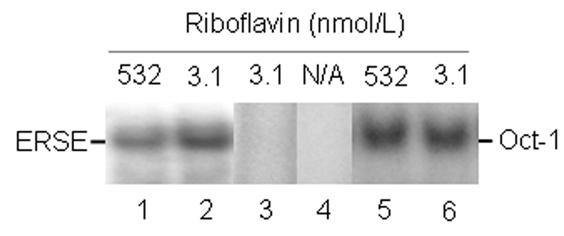Fig. 5.

Riboflavin deficiency enhances binding of transcription factors to endoplasmic reticulum stress elements in HepG2 cells. Cells were cultured in riboflavin-deficient (3.1 nmol/L) and riboflavin-sufficient (532 nmol/L) media for 4 d. Binding to endoplasmic reticulum stress elements was visualized using EMSA; binding to an Oct-1 site was used as a control. N/A = not applicable. Lanes 1 and 2 = binding to an endoplasmic reticulum stress element by nuclear extracts from control cells and riboflavin-deficient cells, respectively; lane 3 = 100-fold molar excess of unlabeled endoplasmic reticulum stress element; lane 4 = endoplasmic reticulum stress element in the absence of nuclear extract; lanes 5 and 6 = binding to a consensus binding sequence for Oct-1 by nuclear extracts from control cells and riboflavin-deficient cells, respectively.
